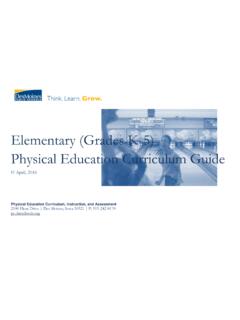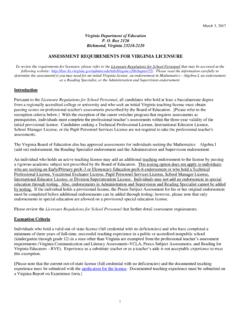Transcription of Middle School (Grades 6-8) Physical Education Curriculum …
1 Middle School (Grades 6-8) Physical Education Curriculum Guide August, 2017 Physical Education Curriculum , Instruction, and Assessment 2100 Fleur Drive | Des Moines, Iowa 50321 | P: 515-242-7241 Middle School Physical Education Curriculum Guide Secondary Curriculum Lead Team Editors High School Lisa Klein, North High School Brianne Burns, Roosevelt High School Matt Carlson, Scavo Alternative High School Terrie Fenstermann, East High School Scott Weinheimer, East High School Ron Wagner, Lincoln High School Sandy Trogdon, Lincoln High School Carrie Harjes, Hoover High School Superintendent Thomas Ahart, Executive Director of Teaching & Learning Noelle Tichy Physical Education Curriculum Coordinator Carlye Satterwhite Elementary Curriculum Lead Team Editors Jessica Johnson, Willard Elementary Matthew Smith, Hillis Elementary Tena Baumgartner, Garton Elementary Tara Frohwein, King Elementary Erik Heard, Edmunds Elementary Monica Sherman.
2 Monroe Elementary Secondary Curriculum Lead Team Editors Middle School Diana Repp Brody Middle School Angel Smyth, Weeks Middle School Catrina Summy, McCombs Middle School Mary-Stuart O Connor, Merrill Middle School John Walling, Goodrell Middle School Tara Stemstrud, Meredith Middle School Middle School Physical Education Curriculum Guide Foreword Curriculum in this document is based on the National PE Standards published in the spring of 2013. It has been developed by Physical educators and Curriculum specialists in the Des Moines Public Schools. The objectives in this Curriculum guide are the minimum requirements in Physical Education that set rigorous, relevant, clear, and measurable learning targets and expectations for what teachers should teach and students should learn. Schools and educators are continuously encouraged to go beyond these targets to better serve the needs of all students in Physical Education .
3 Physical Education Program Mission Statement The Des Moines Public School District s Physical Education Program enhances each student s total wellness through intellectual, social, emotional, Physical , and spiritual development. Middle School Physical Education Curriculum Guide Table of Contents How to use this DMPS PE Learning Middle School Physical Education Curriculum Guide Document Learning Skills and Personal and Social Grade Level Grade Level Common Glossary Middle School Physical Education Curriculum Guide How to use this document: This Curriculum guide is A lock-step instructional guide detailing exactly when and how you teach. Meant to restrict your creativity as a teacher . A ceiling of what your students can learn, nor a set of unattainable goals.
4 Instead, the Curriculum guide is meant to be a common vision for student learning and a set of standards by which to measure and report student progress and provide meaningful feedback. The Curriculum guide outlines which learning goals are most essential for student learning; it is our district s guaranteed and viable Curriculum . The expectation is that every student in our district, regardless of School or classroom, will know and understand these learning goals. As the classroom teacher , you should use the Curriculum guide to help you to decide how to scaffold up to the learning goals, and extend your students learning beyond them. The Curriculum guide is a planning tool; assessed learning topics are provided, but as the instructional leader of your classroom, you determine the scope and sequence in which you will introduce the prioritized learning goals.
5 You are encouraged to create your own sub-units of study within each topic as a starting point. Within this document you will find a foundational structure for planning instruction in the Physical Education classroom which can be supplemented with unlimited materials from any number of sources, including but not limited to district texts. Please consider this guide a living and dynamic document, subject to change and a part of a continuous feedback loop. As part of this logic model. Middle School Physical Education Curriculum Guide Des Moines Public Schools K-12 Student Learning Objectives in Physical Education o Measureable, long-term academic growth targets o Developmentally appropriate activities which assess learning growth for all students o Pre and Post assessment growth of learning o Year-long learning goals using grade level targets to work towards the learning goal Effective Components of a well-designed Physical Education Classroom o Meets the needs of all students o Keeps students active for most of Physical Education class time (minimum 50 instruction/50 movement) o Teaches self-management o Emphasizes knowledge and skills for a lifetime of Physical activity o Is an enjoyable experience for all students The Essential Components of Physical Education (Figure 5)
6 O Policy and Environment o Curriculum o Appropriate Instruction o Student Assessment Middle School Physical Education Curriculum Guide Standards-Referenced Grading Basics The teacher designs instructional activities and assessments that grow and measure a student s skills in the elements identified on our topic scales. Each scale features many such skills and knowledges, also called learning targets. These are noted on the scale below with letters (A, B, C) and occur at Levels 2 and 3 of the scale. In the grade book, a specific learning activity could be marked as being 3A, meaning that the task measured the A item at Level 3. Evidence shows the student Topic Score Demonstrate all learning targets from Level 3 and Level 4 Demonstrate all learning targets from Level 3 with partial success at Level 4 Demonstrate all learning targets from Level 3 Demonstrate some of the Level 3 learning targets Demonstrate all learning targets from Level 2 but none of the learning targets from Level 3 Demonstrate some of the Level 2 learning targets and none of the Level 3 learning targets Demonstrate none of the learning targets from Level 2 or Level 3 Produce no evidence appropriate to the learning targets at any level 0 The Learning Topic is located at the top of the scale.
7 The Learning Goal is the complete Level 3 of the scale. Each lettered bullet point represents one Learning Target. Determining a topic score: when the time comes to identify the Topic Score for a topic, the teacher looks at all of the pieces of the Body of Evidence for that topic. The table to the right describes what Topic Score a student receives based on what the Body of Evidence shows. The scores listed on this table are the only valid scores that may be entered into the Topic Score assignment in a grade book. Multiple Opportunities: It is not about going back to do a retake or make-up a missed PE class, it s about going forward, continually scaffolding student learning through multiple opportunities, and noting their improved learning. Multiple opportunities are about embedding other instructional times for students to showcase their skills that are aligned to the specific learning goal target.
8 Middle School Physical Education Curriculum Guide Standards Referenced Grading Basics Anatomy of a Scale Symbols by the learning levels indicate whether it can be changed, is fixed, or can be enhanced. Triangle symbol designates targets on this level can be changed. This lock symbol designates targets on this level can NOT be changed. These are derived directly from our national standards. This addition symbol designates more targets can be added to this level. No targets are written at this level. learners. For more information: Middle School Physical Education Curriculum Guide Learning Topics for Middle School o Skills and Knowledge o Engagement o Fitness o Personal and Social Behavior Learning goals for all curricular areas are organized by overarching concepts called topics.
9 Within those topics live a learning goal. All learning goals for Physical Education are guided by the 2014 National Society of Health and Physical Education (SHAPE) standards and assessed on the provided reporting scales or checklists. The outline below serves to define the various elements of the Curriculum structure. Learning Topic The Overarching Concept o Definition of the topic. National Standards for K-12 Physical Education : provide a framework for producing physically literate individuals, setting students on the road to enjoying a lifetime of healthful Physical activity. (S1, S2, S3, S4, or S5) Grade level outcomes: provide a scope and sequence of skills and knowledge predicated on teaching a variety of activities to achieve learning for all students. (6th through 8th grade) Teachers should not view outcomes as discrete tasks taught in isolation but rather as a coordinated process that allows students to apply knowledge and skills across standards.
10 Grade level element: Each outcome has been assigned a number but do not necessarily reflect any particular priority. ( meaning- Standard 2, Middle School Outcome 1, Grade 6) Middle School Physical Education Curriculum Guide DMPS Grading Scale Evidence of student learning is assessed on a four-point scale, common throughout the district. Scales are designed to measure each learning topic. The generalized scale, with student-friendly language included, is below. SCALE SCORE ACADEMIC DESCRIPTOR STUDENT-FRIENDLY DESCRIPTOR 4 Exceeding Standard I have demonstrated deep understanding that goes beyond the learning goal 3 Meeting Standard I have met the learning goal 2 Developing Toward Standard I have the foundational skills and knowledge for the learning goal and I am almost there 1 Insufficient Progress The evidence I have submitted shows I have a long way to go to reach the learning goal 0/M No evidence of student understanding in submitted work OR Missing student has not submitted evidence I have not submitted evidence of learning for the learning goal *For more information on district assessment and grading practices, please refer to the Grading Practices website Guiding Practices of Standards-Referenced Grading 1.




